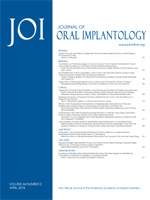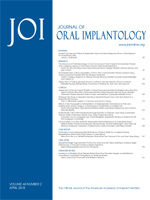
Journal of Oral Implantology Volume 47 Issue 5
The researchers stated that future studies should also focus on membrane thickness as well as examining residual concentrations of various grafting materials after epithelial closure.
LAWRENCE, Kan. (PRWEB)
November 02, 2021
Journal of Oral Implantology – After tooth extraction, alveolar ridge collapse can cause serious dental complications in patients for future implant surgeries. Preservation of the alveolar ridge helps to secure bone structure essential for the eventual successful dental implant placement. Traditionally, a type-1 bovine collagen membrane has been used to strengthen the ridge, but researchers are looking into alternative materials to assist in healing, function, and esthetics. “Jawbone preservation after tooth removal maintains the bone’s volume and quality for future implant placement,” researchers from the College of Dentistry, University of Kentucky, Lexington, and a private dental practice, Houston, Texas, state. They recently published the findings of their randomized controlled clinical study in the Journal of Oral Implantology that evaluates the use of human amnion-chorion membrane compared with a traditional type-1 bovine collagen membrane in an exposed socket preservation technique.
In their analysis, the researchers identified 43 patients that needed tooth extraction followed by a delayed implantation procedure. The patients were split into a 21-person experimental group receiving a human amnion-chorion membrane (experimental) and a 22-person control group receiving a bovine collagen membrane (control). The researchers wanted “to determine if intentional membrane exposure compromises ridge dimensions and bone quality.”
Researcher Ahmad Kutkut summarized the results by stating, “The volunteers underwent implant placement after an average healing period of 19.5 weeks. Core bone specimens were obtained for histomorphometric analyses. In addition, the clinical ridge dimensions were measured after extraction and at the time of delayed implant placement. As a result, no significant difference was observed between the experimental and control groups in the quality of the vital bone formation. In addition, the bone height and width did not differ, as determined by clinical measurements.”
The findings of this study suggest that using a human amnion-chorion membrane to aid in alveolar ridge preservation had no significant difference from using the traditional type 1 bovine collagen membrane. The researchers stated that future studies should also focus on membrane thickness as well as examining residual concentrations of various grafting materials after epithelial closure.
Dr. Kutkut reiterates these conclusions by saying, “Using a human amnion-chorion membrane as an open barrier did not compromise the healing or affect bone quality and quantity at the extraction sites.”
Full text of the article, “Comparison of Dehydrated Human Amnion-Chorion and Type 1 Bovine Collagen Membranes in Alveolar Ridge Preservation: A Clinical and Histological Study” Journal of Oral Implantology, Vol. 47, No. 5, 2021, is available at https://doi.org/10.1563/aaid-joi-D-19-00335
###
About the Journal of Oral Implantology
The Journal of Oral Implantology is the official publication of the American Academy of Implant Dentistry and of the American Academy of Implant Prosthodontics. It is dedicated to providing valuable information to general dentists, oral surgeons, prosthodontists, periodontists, scientists, clinicians, laboratory owners and technicians, manufacturers, and educators. The JOI distinguishes itself as the first and oldest journal in the world devoted exclusively to implant dentistry. For more information about the journal or society, please visit http://www.joionline.org.
Share article on social media or email:

